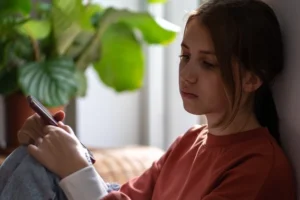Back in April, a 12 and 13 year old were arrested by Lancashire police for the possession of indecent images of minors. This, alongside headlines about how children as young as seven have been involved with ‘sexting’, highlighted the vulnerability of our children when it comes to making sensible decisions about how they use their smartphones and share images of themselves on social media.
Quite rightly police have warned youngsters to think carefully about how they use social networks and how they could end up on a sex offenders list if they are caught creating or sending a naked selfie.
However, a warning is one thing, heeding it is quite another.
Difficulties addressing the issue
There’s no doubt online safety is a difficult path to navigate. Today in Britain, 65% of eight to 11 year olds own a smartphone, and a BBC survey in February showed 78% of children aged under 13 had at least one social media account.
Considering the lower age limit for most social media sites is 13, parents can find themselves playing a tug of war with their emotions. Give your child a phone and you feel you’ve given them a lifeline if the worse happens, yet you’re also handing them a pass to grow up too quickly and take decisions they might not be mature enough to make.
For teachers, the effects are just as difficult to manage, not least because there is the expectation that the education system will guide the child; an ideal situation for the more laissez-faire parent.
How we manage the problem and keep our children safe online has long been debated. Charities like the NSPCC, through bodies like Internet Matters, Parentzone and Childnet, and the government – including the UK Minister for Internet Safety and Security Baroness Joanna Shields – have worked together to raise awareness and provide the teaching profession and parents with the help they need to support children and keep them safe.
Making tricky decisions
But there will always be the tricky decision for parents to make. How do you use the guidance that suits your family dynamics? Police your child at the risk of alienating them, or give them the freedom to learn by their mistakes? Clearly, as the parents of the teenagers in Lancashire will have discovered, mistakes can lead to irreversible consequences so the burden of decision is great.
The Lancashire event illustrated how much there is to lose; a criminal record effectively curtailing job and education prospects. It also raised the questions about when education should start, with a strong ethos that the younger a child is the better.
So what’s the answer? Who is accountable? Can it all be about the parent and the teaching community? What of the manufacturers of phones, the social media networks, or indeed the mobile operators?
Last December the EU put forward the idea of a legal age of 16 for using social media. It was canned because no one could agree. And there lies the rub. We agree something needs to be done but would regulation or legislation be enough on its own? The answer is no.
We at Internet Matters strongly believe the most important thing is making sure parents play a leading role in their children’s digital lives.
The internet is a force for good and has enormous benefits. But – just like in their everyday lives offline – we need to be involved in their online world every step of the way.
This means making sure we have those vital conversations with our children about the issues which pose the greatest potential risks; from cyberbullying to grooming, and from privacy to exposure to extreme content.
How technology can help
Technology can play an essential role in triggering these conversations in the first place and it is encouraging to see how industry is progressively building and launching new products with the sole intention of keeping children safe online.
Yet we are still learning about what works and what doesn’t. The challenge is to find the technology that balances the needs between control and empowerment.
Artificial intelligence (AI) is one of the most exciting developments in this area with some believing it could be a breakthrough moment for internet safety. There have been some dramatic advances in this technology. A smart assistant on a phone is now capable of helping a child who has unwittingly posted an inappropriate photo on Instagram or his phone number on Twitter delete or change their post.
AI can intervene immediately and give the child tailored advice as soon as they do something foolish helping them understand why it was a risk, and importantly show them how to reverse their choice. It has the potential to prevent innocence from being a child’s downfall without it feeling like big brother.
That in itself could be a big deal. Can we give children the help they need exactly when they need it? Could it apply classroom and dining room table discussions to the real world, empower children and let them learn in a safe environment? This is the goal.
Combining AI and parent-child conversations
With the right implementation, neither too intrusive nor giving parents a false sense of security, AI could be the trigger for parent-child conversations.
And, perhaps most interestingly, AI is being paired with services that alert parents when there has been an intervention, giving specific advice on how to have a conversation with the child that’s positive and supportive.
This gives the parents a sense of control, a feeling they can trust their child, yet the peace of mind they are letting their child find their digital independence.
Using AI in this way could help raise the alarm more quickly on the likes of self-harm, bullying, grooming, radicalisation and mental health. The technology can analyse the images your child is posting or being sent online, from recognising if there is too much flesh on show in a selfie, to sending alerts on images that are violent and abusive, or showing self-harm and even anorexia.
Many think artificial intelligence is still bound to The Matrix. But in fact it’s a reality now and needs to be embraced. This year we’re looking forward to seeing products launch that allow us to make huge step forward in the right direction – one of the first such tools we’ll see bring the vision to life is Oytoy and it promises to crack the conundrum of peace of mind and freedom.
Of course, this technology isn’t going to be the cure-all. But if it’s developed so that the needs of control and empowerment are properly balanced and we couple it with structured education, then it could be key in the battle to keep future generations safe online.





